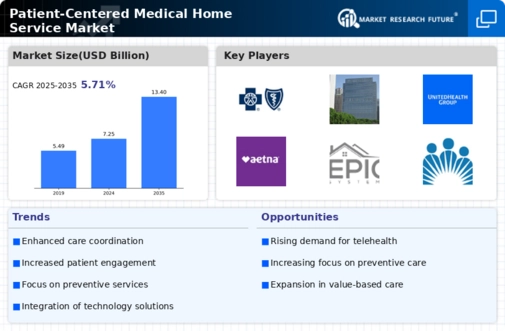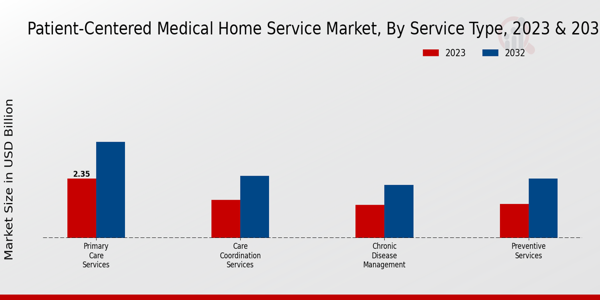Growing Aging Population
The Global Patient-Centered Medical Home Service Market Industry is significantly influenced by the growing aging population, which presents unique healthcare challenges. As individuals age, they often require more complex and coordinated care, making patient-centered medical homes an attractive solution. This demographic shift is prompting healthcare systems to adapt and invest in models that cater to the needs of older adults. The increasing prevalence of chronic conditions among the elderly further underscores the necessity for integrated care approaches. Consequently, the market is expected to expand, driven by the demand for services that effectively address the complexities of aging and chronic disease management.
Market Growth Projections
The Global Patient-Centered Medical Home Service Market Industry is poised for substantial growth, with projections indicating a rise from 7.25 USD Billion in 2024 to 13.4 USD Billion by 2035. This growth trajectory reflects a compound annual growth rate of 5.72% from 2025 to 2035. Such figures highlight the increasing recognition of the value of patient-centered care models across the globe. As healthcare systems continue to evolve, the demand for integrated and coordinated care is likely to drive further investments in patient-centered medical homes, ensuring their relevance and sustainability in the future.
Increased Focus on Preventive Care
The Global Patient-Centered Medical Home Service Market Industry is witnessing a heightened emphasis on preventive care strategies. This focus aligns with broader public health initiatives aimed at reducing the incidence of chronic diseases and improving overall population health. By prioritizing preventive measures, healthcare systems can potentially lower long-term healthcare costs and enhance patient quality of life. The market's growth trajectory is supported by this trend, as stakeholders increasingly invest in preventive care models. The anticipated compound annual growth rate of 5.72% from 2025 to 2035 underscores the potential for patient-centered medical homes to play a crucial role in fostering healthier communities.
Rising Demand for Coordinated Care
The Global Patient-Centered Medical Home Service Market Industry experiences a notable increase in demand for coordinated care models. This shift is driven by a growing recognition of the benefits of integrated healthcare services, which enhance patient outcomes and satisfaction. As healthcare systems evolve, there is a clear trend towards models that prioritize patient engagement and comprehensive care management. In 2024, the market is projected to reach 7.25 USD Billion, reflecting the increasing investment in patient-centered approaches. This trend is likely to continue, as stakeholders recognize the potential for improved health outcomes and reduced costs associated with coordinated care.
Policy Support and Reimbursement Models
The Global Patient-Centered Medical Home Service Market Industry benefits from supportive policies and evolving reimbursement models that incentivize patient-centered care. Governments and healthcare organizations are increasingly recognizing the value of medical homes in improving care quality and reducing costs. Legislative measures aimed at promoting value-based care are likely to enhance the financial viability of patient-centered medical homes. This supportive environment encourages healthcare providers to adopt these models, thereby driving market growth. As reimbursement structures evolve to favor coordinated care, the market is poised for significant expansion, reflecting the growing alignment of financial incentives with patient-centered approaches.
Technological Advancements in Healthcare
Technological innovations play a pivotal role in shaping the Global Patient-Centered Medical Home Service Market Industry. The integration of telemedicine, electronic health records, and health information exchanges facilitates seamless communication among healthcare providers and patients. These advancements not only improve access to care but also enhance the efficiency of service delivery. As technology continues to evolve, it is expected that the market will grow significantly, with projections indicating a rise to 13.4 USD Billion by 2035. The ongoing development of digital health solutions is likely to further support the expansion of patient-centered medical homes, making healthcare more accessible and personalized.


























Leave a Comment